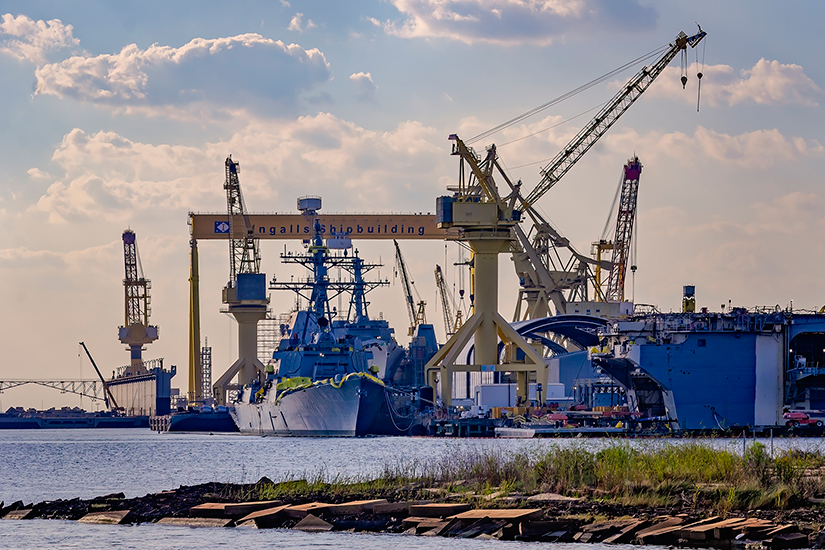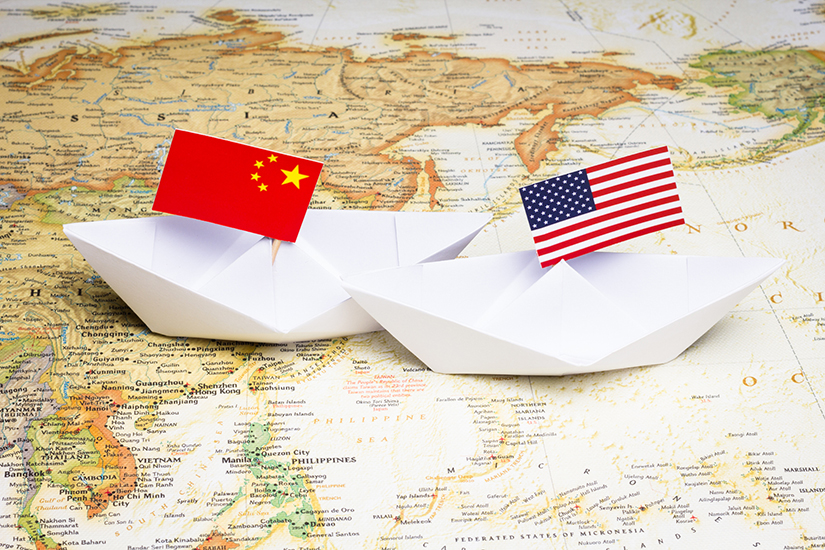The Decline of the U.S. Shipbuilding Industry and the Challenge of Maintaining Naval Power
The preeminent status of the U.S. Navy faces an unprecedented threat. Naval power fundamentally relies on shipbuilding capacity, yet the U.S. civilian shipbuilding sector has sharply declined. The hegemony in shipbuilding, which transitioned from Great Britain to the U.S. in the mid-20th century, has subsequently migrated through Japan and South Korea before ultimately arriving in China[1]. As of 2024, Chinese shipyards account for over 55% of global commercial vessel production, while the U.S. share has dropped to 0.1%[2]. The American shipbuilding industry, once supported by more than 60 large shipyards, now operates with only 20 facilities[3].
U.S. concerns over China’s rapid naval expansion are intensifying. While the U.S. Navy still leads in total fleet displacement, China has overtaken the U.S. in the number of warships, fielding over 370 vessels compared to the U.S.’s 296 as of late 2024[4]. In response, Washington is pursuing a broad strategy to revitalize domestic shipbuilding and reinforce maritime strength. Recent initiatives include several legislations in Congress and executive orders such as “Restoring America’s Maritime Dominance”.
This paper analyzes the regulatory frameworks that have precipitated the decline of the U.S. shipbuilding industry, then examines current policies aimed at reforming these constraints to achieve a revitalization of the sector and, by extension, the restoration of U.S. naval power. Additionally, it investigates the significance of “cooperation with allies”, a recurring theme in recent policy discourse, and explores the inherent dilemmas of such collaborative efforts.

Structural Constraints on U.S. Shipbuilding and Naval Force Development
The decline of U.S. shipbuilding can be attributed to several structural factors. The most deeply rooted of these is protectionist regulation such as the Merchant Marine Act of 1920, commonly known as the "Jones Act[5]," which mandates that all vessels engaged in U.S. coastal trade be constructed in the U.S., registered under the American flag, and owned and operated by U.S. citizens[6]. Although the Jones Act was enacted to shield domestic shipbuilders, the excessive protection has insulated U.S. shipyards from global competition, diminishing incentives for investment in facilities and technology. Consequently, the U.S. shipbuilding industry has fallen behind in competitiveness[7].
The negative effects of the Jones Act have long been criticized, but reforms have not been forthcoming because of its ties to the employment of shipyard workers. The beneficiaries of the protectionist legislation have continued to lobby Congress to keep it in place. Amendments to or repeal of the Jones Act could inflict adverse economic consequences on regions where the shipbuilding industry is concentrated. Nevertheless, as the number of shipbuilding workers itself has declined - from 750,000 in the 1940s[8], 180,000 in the 1980s[9], and 105,000 in 2023[10] - legislative initiatives to permit construction in foreign shipyards are beginning to gain traction[11].
In addition to the Jones Act, limited financial support from the government has accelerated the decline of the shipbuilding industry. In 1981, the Reagan administration terminated funding for the federal subsidy program that had offset the cost difference between U.S. and foreign shipbuilding[12]. Consequently, only a few shipyards that take federal resources for naval shipbuilding have survived. In stark contrast, China has secured global market dominance by providing its shipyards with substantial financial support, including production subsidies, entry subsidies for new participants, and investment subsidies. For example, between 2006 and 2013, the Chinese government allocated approximately $91 billion in subsidies to its shipbuilding sector, whereas the U.S. extended only $1.5 billion[13][14].
Shipyards hampered by legal restrictions and limited financial support cannot sustain adequate facilities and workforce. Currently, wages of shipyard workers are not significantly different from those of retail workers[15], which leads to inefficient work processes and delivery delays even at the few remaining naval shipyards[16]. However, the U.S. cannot solve its naval shipbuilding needs by purchasing overseas or offshoring to foreign shipyards. This is because there are other protectionist regulatory measures separate from the Jones Act.
For example, the Buy American Act of 1933 requires that all goods procured by the U.S. Department of Defense be produced or manufactured substantially in the U.S., either as final products or in terms of their component parts[17]. Furthermore, the Byrnes-Tollefson Act of 1983 prohibits the construction of naval vessel hulls or superstructures in foreign shipyards[18]. Although a presidential waiver exists[19], its scope is narrow and has never been exercised. Amid the sharp decline of the overall shipbuilding industry, including the naval sector, these restrictions have become barriers to maintaining the size of the U.S. Navy fleet.
Policies for Revitalizing U.S. Shipbuilding and Naval Force Construction
The U.S. clearly recognizes the decline in its shipbuilding industry and the resulting erosion of Naval power. Domestically, efforts are underway to amend protectionist laws requiring domestic production, provide financial support for shipyards, impose sanctions on China’s shipbuilding sector, and cooperate with allied nations.
A prominent example is the Shipbuilding and Harbor Infrastructure for Prosperity and Security (SHIPS) for America Act, jointly introduced on December 19, 2024, by Democratic Senator Mark Kelly and Republican Senator Todd Young[20]. Reflecting priorities from the May 2024 Congressional Guidance for National Maritime Strategy, the legislation aims to grow the U.S.-flagged international trading fleet from 80 to 250 vessels within ten years[21]. Instead of altering the domestic construction mandates of the Jones Act, this legislation focuses on boosting competitiveness through public funding, incentives, and support for workforce development, which is similar to China’s strategy, to revitalize U.S. shipbuilding while sidestepping political delays.
The second notable initiative is the Ensuring Naval Readiness Act, reintroduced on February 5, 2025, by Republican Senators Mike Lee and John Curtis[22]. Crucially, this Act allows construction of naval vessels or components in shipyards of NATO member states or Indo-Pacific nations with U.S. mutual defense agreements. It aims to cut costs and speed up delivery, addressing the gap between current capacity and requirements. The legislation attempts to bypass the restrictions imposed by the Byrnes-Tollefson Act, with the condition that construction occurs in allied shipyards and excludes any involvement by entities affiliated with China[23]. This measure is projected to offer the U.S. Navy an opportunity to achieve its fleet building goals within a compressed timeframe.
Beyond legislative efforts, the pivotal step is the executive order “Restoring America’s Maritime Dominance,” issued by the Trump administration on April 9, 2025[24]. Against the backdrop of China producing nearly half of the world’s commercial vessels while the U.S. constructs less than one percent, the order mandates the reconstruction of America’s long-neglected shipbuilding industry and maritime workforce to advance both national security and economic prosperity.
According to the executive order, the National Security Advisor is tasked to develop a Maritime Action Plan (MAP) within 210 days. This plan includes creating a Maritime Security Trust Fund, a Shipbuilding Financial Incentives Program, and Maritime Prosperity Zones. The Department of Defense is tasked with assessing the maritime industrial base within 180 days, the Department of Commerce with proposing a financial incentives program within 90 days, and the Department of Transportation with reporting on maritime workforce training. The U.S. Trade Representative is directed to propose actions against China’s anticompetitive practices, while the order also promotes investment by allied shipbuilders in the U.S. and seeks to align trade policies with allies to address China’s unfair trade practices[25]. Overall, the executive order marks the beginning of a long-term strategy to restore U.S. maritime power and gain an edge over China.

The Dilemma of Two Policy Goals – Protectionism and Partnership with the Allies
Despite these initiatives, challenge remains. The U.S. is attempting to pursue two objectives simultaneously: the revival of domestic shipbuilding and the rapid expansion of its naval power. The means to achieve these goals may be at odds. Financial support provided by Trump’s executive order, including potential investments from allies, may gradually rebuild the industry. However, shortages in existing facilities and skilled labor hinder a rapid response to naval competition. Conversely, the Ensuring Naval Readiness Act, supported by Republicans, proposes procuring ships from allied nations to meet immediate fleet requirements. However, this approach sidesteps the underlying issues in U.S. shipbuilding and is inconsistent with Trump’s broader agenda of restoring U.S. manufacturing. Thus, although the Trump executive order and the Ensuring Naval Readiness Act both call for allied cooperation, they do so in different contexts. The U.S. must develop a balanced approach that addresses both short-term naval requirements and long-term industrial revitalization.
In conclusion, revitalizing the U.S. shipbuilding industry while rapidly expanding naval capabilities presents a dual challenge requiring coordinated policy. Given the urgency posed by China’s maritime expansion, cooperation with allies is not merely an option but a necessity. Specifically, South Korea and Japan, as leading U.S. allies in the Indo-Pacific and global frontrunners in shipbuilding technology and capacity, are positioned to support U.S. efforts. Their advanced shipyards and established defense partnerships make them collaborators for both bridging capability gaps and facilitating the transfer of best practices and innovation to the U.S. shipbuilding sector. By implementing a flexible approach—from direct procurement to hybrid construction and allied investment in U.S. facilities—the U.S. can address immediate fleet gaps while fostering industrial renewal. Such collaboration will not only bolster U.S.’s maritime power but also reinforce a free and open Indo-Pacific order, providing a resilient foundation against future challenges. The following article will examine how the U.S. will shape its shipbuilding policy, focusing on the implementation of Trump's executive orders and trends in international cooperation and investment in the U.S. shipbuilding sector.

(2025/05/21)
Notes
- 1 “Industrial policy: Lessons from shipbuilding “, Center for Economic Policy Research, November 5, 2024.
- 2 The Whitehouse, Fact Sheet: President Donald J. Trump Restores America’s Maritime Dominance, April 9, 2025.
- 3 Tim Colton, “U.S. BUILDERS OF LARGE SHIPS “, Shipbuilding History.
- 4 Congressional Budget Office, An Analysis of the Navy’s 2025 Shipbuilding Plan, January 6, 2025.
- 5 The U.S. Merchant Marine Act of 1920 is commonly referred to as the "Jones Act" because it was introduced by Senator Wesley L. Jones of Washington.; John F. Frittelli, “The Jones Act: An Overview“, CRS Report for Congress, July 8, 2003.
- 6 46 United States Code §§861-869.
- 7 “Op-Ed: The degradation and recovery of U.S. shipbuilding”, Marine Log, December 3, 2024.
- 8 Ibid.
- 9 “Decline in U.S. Shipbuilding Industry: A Cautionary Tale of Foreign Subsidies Destroying U.S. Jobs”, Eno Center for Transportation, September 1, 2015.
- 10 U.S. Maritime Administration, Fact Sheet for Domestic Shipbuilding, July 25, 2024.
- 11 “U.S. targets Jones Act amendment to boost South Korean shipbuilding opportunities”, Hellenic Shipping News Worldwide, March 18, 2025.
- 12 “Op-Ed: The degradation and recovery of U.S. shipbuilding”, Marine Log, December 3, 2024.
- 13 “Why US Sanctions Against China`s Shipbuilding Sector Are Only Matter of Time”, Valdai Club, June 21, 2024.
- 14 “Industrial policy: Lessons from shipbuilding “, Center for Economic Policy Research, November 5, 2024.
- 15 “Labor Shortages Hit US Navy Shipyards but Pay Raises Could Fix the Problem: Experts”, Special Operations Forces Report, March 12, 2025.
- 16 “Higher pay for shipyard workers critical for military shipbuilding revival, experts say”, Stars and Stripes, March 11, 2025.
- 17 41 U.S.C. §§ 8301–8305.
- 18 10 U.S.C. § 8679.
- 19 Brian T. Di Mascio, “Foreign Shipyards Can Help the U.S. Navy Build Its Fleet”, Proceedings, October 2024, Vol. 150/10/1,460.
- 20 “The SHIPS for America Act Is Launched in Congress”, The National Law Review, January 6, 2025.
- 21 New SHIPS Act Legislation Aims to Revamp U.S. Shipbuilding Industry, USNI News, December 19, 2024.
- 22 “Utah’s Senators Introduce Bills for Navy and Coast Guard Readiness“, Mike Lee Press Release, February 5, 2025.
- 23 S.4531, Ensuring Naval Readiness Act.
- 24 The Whitehouse, RESTORING AMERICA’S MARITIME DOMINANCE, April 9, 2025.
- 25 Ibid.

